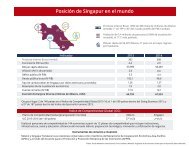basic-guide-to-exporting_Latest_eg_main_086196
basic-guide-to-exporting_Latest_eg_main_086196
basic-guide-to-exporting_Latest_eg_main_086196
Create successful ePaper yourself
Turn your PDF publications into a flip-book with our unique Google optimized e-Paper software.
Answer these 11 questions:1. Which products are selected for export development, and what modifications, ifany, must be made <strong>to</strong> adapt them for overseas markets?2. Is an export license needed?3. Which countries are targeted for sales development?4. In each country, what are the <strong>basic</strong> cus<strong>to</strong>mer profiles, and what marketing anddistribution channels should be used <strong>to</strong> reach cus<strong>to</strong>mers?5. What special challenges pertain <strong>to</strong> each market (for example, competition,cultural differences, and import and export controls), and what strat<strong>eg</strong>y will beused <strong>to</strong> address them?6. How will your product’s export sales price be determined?7. What specific operational steps must be taken and when?8. What will be the time frame for implementing each element of the plan?9. What personnel and company resources will be dedicated <strong>to</strong> <strong>exporting</strong>?10. What will be the cost in time and money for each element?11. How will results be evaluated and used <strong>to</strong> modify the plan?The first time an export plan is developed, it should be kept simple. It need be only afew pages long because important market data and planning elements may not yetbe available. The initial planning effort itself gradually generates more informationand insight. As you learn more about <strong>exporting</strong> and your company’s competitiveposition, the export plan will become more detailed and complete.From the start, your plan should be written and viewed as a flexible management<strong>to</strong>ol, not as a static document. Objectives in the plan should be compared withactual results <strong>to</strong> measure the success of different strat<strong>eg</strong>ies. Your company shouldnot hesitate <strong>to</strong> modify the plan and make it more specific as new information andexperience are gained.A detailed plan is recommended for companies that intend <strong>to</strong> export directly,meaning selling <strong>to</strong> an end-user in another country. If your company chooses indirectexport methods or sells via your or a third party’s website, you may use muchsimpler plans. For more information on different approaches <strong>to</strong> <strong>exporting</strong> and theiradvantages and disadvantages, see Chapter 5.The Value of a PlanOnly about a third of SME U.S. manufacturers have a written plan of any size or kind.These companies b<strong>eg</strong>an <strong>exporting</strong> by responding <strong>to</strong> an order and tend <strong>to</strong> react onlywhen additional orders come in the same way, often via the Internet. No revenuetargets for exports exist, and no one staff member is dedicated <strong>to</strong> growing theexport business.Absent a plan, your business may overlook much better opportunities. In addition,reactive exporters may quickly give up on selling <strong>to</strong> international cus<strong>to</strong>mers,18U.S. Commercial Service • A Basic Guide <strong>to</strong> Exporting





